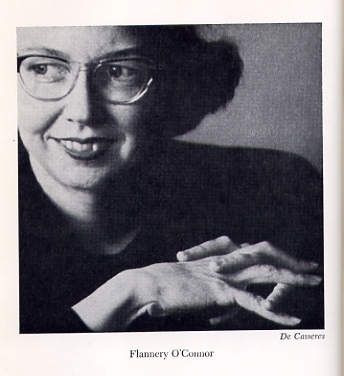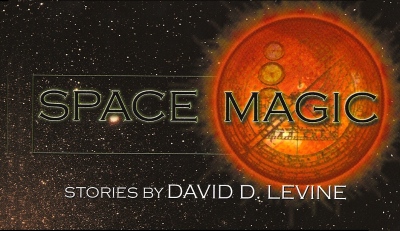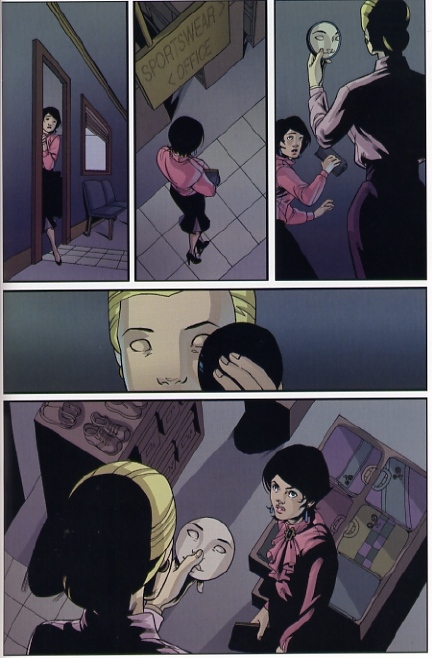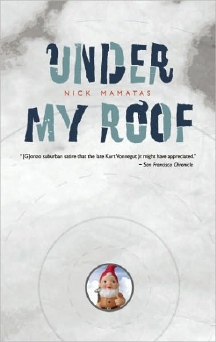|
|
|
|
This Just In...News
From The Agony Column
|
| |
|
09-26-08: 'The Necklace' by Cheryl Jarvis
|
"What we get
back when we put it on someone else's neck, that's what's meaningful
to us"
|
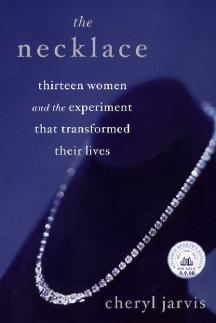
|
Something around your neck. |
I manage to back myself
into some pretty impressive corners, but none, so far, have matched my
decision to interview the women who were described in 'The Necklace: Thirteen
Women and the Experiment That Transformed Their Lives' (Ballantine / Random
House ; September 2008 ; $24) by Cheryl Jarvis. Janet
Leimeister over at Capitola Book
Café asked me about this, suggesting it might be fun for me
to talk to a couple of them. But it proves to be just a bit more complicated
than one might presume.
First, it helps to get a sense of the book, which though it might sound
overly girly is actually pretty good. Jonell McLain is a fifty-something,
self-described ex-hippie who lives in the seaside burg of Ventura, California.
One day, she's strolling through the mall and sees a diamond necklace
in the window of a jewelry store. It's pretty nice – and very expensive,
with a sticker price of $37,000. She gets it in her head that she's going
to perform this "experiment", which is to buy the necklace with
twelve other women splitting the price. They'll each get it for 28 days
out of the year, meeting once a month to swap it and tell tales of what
"Jewelia" has done. (They named the necklace after Julia Child.)
The book that resulted is a short, fast read, with thirteen chapters that
track the experiment and offer thumbnail portraits of each participant,
and a wrap-up chapter to conclude. The upshot of this experiment was not
a parade of ostentatious displays of wealth, but rather, the opposite.
The women who gathered together and became, well, sort of friends, and
certainly a sorority, decided to used the necklace and their deal to take
the opportunity to give back to their community. They'd hold fundraisers
for various local charities and ended up doing quite a bit of good. They
also got into a fair amount of minor-league mischief (my term, not theirs!)
doing things like leaving it on a front porch, skydiving with it, taking
it to gynecological exams – actions that dont leap to mind
when you see the necklace itself. The book pivots around the responses
to the necklace, which are definitely not what youd expect.
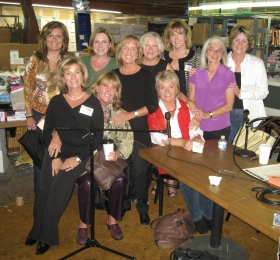
|
|
|
Put your name here .... |
That's the book; the
interview, well a very different matter. First off, the author didn't
show up for the interview – only the women, if, in fact the word
"only" could be applied to the ten (ten?) – I think it
was ten, I'll have to check the photo and count – who showed up.
Even though I'd been told I should only talk to a couple of them, I decided
that I'd not pass up the chance to speak to all of them. So, picture this:
Rick Kleffel in the attic of the Capitola Book Café with ten aggressive,
intelligent women – who prove to be not so unified as one might
presume.
In the first place, there were the recording challenges. I've done these
large-scale interviews before for KUSP's Life Under the Lights, so I had
the gear and managed to get it set up before they arrived. Once I got
past the gearhead aspect, the more formidable problem presented itself.
That is, how to get ten smart, verbal women to speak in an orderly fashion?
Here, the fact that they're women isnt such an issue, but still,
puh-leeze – ten people? It was a prescription for chaos. But I was
given fair enough warning by one of the group, Roz Warner ("The Leader"),
and a fairly succinct explanation of what I wanted resulted in a very
orderly, but nonetheless fascinating interview. And heres where
the unknown came into play, because you know that the unknown is going
to make an appearance in this sort of situation.
These women who had spent, for the most part, some four years together,
were neither homogenous nor unified. I'd keep thinking that sure they'd
all agree on this or that, but without fail they displayed a much more
casual camaraderie than I expected. Many told me point-blank they said,
"No," when first asked if they'd like to participate. There
was a bit of dissention in the room. But that dissention and disagreement
was matched by their emphasis on the good they'd done together, on the
joy they found sharing the necklace not just among themselves, but with
others outside the group. Their stories are funny, witty and quite compelling.
The odd feeling, I think is also there. They're comfortable together,
surely – but it's not the sort of comfort one might expect of a
group of friends. There's a tension there, and I think you can hear it
on the tape. Of course, I can't discount the fact that there was one gentleman
in the room. My presence certainly must have shifted the vibe. But I think
the interview tape makes it pretty clear that this necklace, this experiment
was successful in ways nobody imagined.
The Necklace itself; well I suppose it was pretty spectacular. Tina Osborne
("The Reluctant") was wearing it, and sitting next to me at
the head of the table. I stared at it for a while, wondering if that was
it – and it was. You'll
hear in this link to the audio interview, when I ask her about it.
To be honest – I would have been more impressed to see some sort
of electronic gadget, like maybe the new Google phone. Frankly, if you
ask me, the book is a LOT more interesting than Jewelia. I think the women
who participated would likely find that something they could
agree upon.
|
| |
|
09-25-08: For Jeffrey J. Mariotte the 'River Runs Red' ; Agony Column
Podcast News Report : SF in SF, Featuring Nick Mamatas, David Levine
and Terry Bisson (3)
|
From The Slab to
the Cave
|
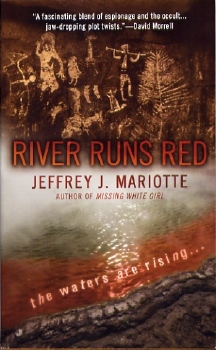
|
An artery runs through it. |
Jeff Mariotte
is a busy guy. Between co-owning and managing Mysterious
Galaxy from his ranch, his work on comic books and his YA novels,
it's pretty hard to believe he still has time to write full-blown horror
like 'The Slab',
an excellent evocation of the California high-desert culture embedded
in a Lovecraft-inspired eighties-style horror novel. Because he'd gone
off in so many different directions at once, I'd actually lost track of
Mariotte. When his latest novel, 'River Runs Red' (Jove / Berkley / Penguin
Putnam ; October 7, 2008 ; $6.99) arrived, I almost missed it. The packaging
is, to say the least, a bit on the anonymous side. And as well, 'The Slab'
was a small-press production by Jeff Mariotte, not "Jeffrey J. Mariotte".
But I'm always up for a mass-market paperback treasure. Horror novels
seem a bit scarier when they're sort of sleazy. It's a lot easier for
them to slip you the literary knife when your expectations are low. On
the flip side, you can miss a good book. Keep your expectations in check,
but dont miss 'River Runs Red'.
Mariotte offers readers wide-screen start-up, with psychics, the CIA,
and three key characters scattered around the globe edging closer to one
another, their past and of course, the Place. Mariotte's great with Place,
and in this case, he's back out in the desert again, this time just outside
a small Texas town. There's a cave there, and from it blood and plot will
flow with equal regularity and power. The forces behind the world, the
gods and demons and whatnots that drive our reality from behind the veil
of dreams, nightmares and psychic visions are locked in a battle that
is having repercussions in our world. Generally bad ones, except for those
of us who enjoy reading wel-written, wel-paced classic horror.
Mariotte's mixed in more than a bit of spycraft into his horror novel,
which gives the book a faster pace and an intelligent edge. Oh, we all
know that the government is dealing with aliens, ghosts and displkaced
gods, but its still a lot of fun to see it unfold on the printed
page with the kind of skill that Mariotte brings to the party. And this
is a party book, a good old-fashioned but original spin on what happens
when humans are in the presence of power. You can get Hiroshima, or you
can get the supernatural equivalent, running in the rivers of this world.
Either way, it so happens that we dont deal too well with power
and powers. But we make good food!
There used to be a time when you couldnt escape from mass-market
paperback horror and most of it was not worth your time. Mariotte keeps
you entertained and gives your gray cells something to chew on while they're
helping you manufacture monsters in your mind's big-screen, surround-sound
theater. Some twenty years ago, this novel might have been given the gerund
treatment and titled The Running,' or 'The Glowing'. The cover would have
included raised foil lettering. It would have been unmistakably horror.
I'm not sure what exactly the current cover design looks like; but it
doesn't say horror. It does include a cover blurb however, with the word
"occult", so I suppose there's something to be thankful for.
Nowadays, you can escape from horror fiction; but dont let this
horror fiction escape from you.
|
Agony Column Podcast
News Report : SF in SF, Featuring Nick Mamatas, David Levine and Terry
Bisson: Panel Discussion
In the final podcast
of the SF in SF show from September 20, 2008, David Levine,
Nick Mamatas and Terry Bisson discuss
their work. In this way, SF in SF is like a monthly science fiction /
fantasy / horror convention – you get readings and a "battle
of the words" effect. You
can find your link – and mine – to the MP3 file right here.
|
| |
|
09-24-08: Finding Flannery ; Agony Column Podcast News Report : SF in
SF, Featuring Nick Mamatas, David Levine and Terry Bisson (2)
|
Everything That
Rises Must Converge

|
|
|
Ms fnd in Logos. |
Apparently, having
done so, it all blows up. And the upshot is that readers spend more than
a little time in the used bookstores, looking for that money-saving title
that still satisfies after all these years.
If you toss out the money-saving aspect, I've got the title that still
satisfies after all these years. But let me rewind a little and set the
scene. Anyone who takes an occasional gander at the Rolling Shelves knows
I get more books than I want, need or have time to deal with. Lots of
those go to the local library, but even they have their limits. The last
time I showed up with ten grocer bags full of stuff they literally told
me: "Please dont come back for six months. We can't handle
all these books." Fair enough, I take the leftovers to Bookshop
Santa Cruz, or Logos.
Logos has the tendency to give me these pink trade slips, which allow
me to buy used books or CDs. So it was that last Sunday I found myself
perusing the used book shelves at Logos. It was a half-hearted effort.
I just drifted away from the CDs and there, at the end of the aisle on
the wall, it's the "O's". A hardcover white spine with black
lettering caught my attention; it stood out from all the colors. It was
simple and compelling.
Flannery O'Connor
In spiky black. A gothic, picket fence.
Everything That Rises Must Converge.
Blue, block lettering.
Hmm, I think. A book club edition, in a Demco cover. Maybe a nice reader
for some of my favorite stories. I have all of them in the Complete Stories
trade paperback, but that's kind of ratty. And we're heading into Flannery
O'Connor-esque times, to my mind. Down times. I pluck it off the shelf,
open it up and get a surprise.
$4.95
Book club editions are not priced. Now I'm excited. I flip to the colophon
page. First printing, 1965. It's 43 years old and in perfect shape. The
title page has a lightly penciled-in price of 1st ED 30-. On the facing
a page, a photo of the author, who died in 1964 at the age of 38. She
was a young woman. I have to admit, it brought a tear to my eye.
|
If
you are among the very young at heart. |
I really love Flannery O'Connor's writing. She's tough, but smart and
strong enough to explore her characters in a way to reveal their deep
weaknesses with clarity, tragedy and a certain amount of distant sympathy.
Theyre all going to fail, and generally not in a spectacular fashion.
They'll fail themselves, and as I stood there, feeling failure close in
on me, I knew I wasn't alone. Across all those years, from a culture so
distant to mine that I knew we would view one another almost as aliens,
I could feel that tug of power that great writing offers, the solace of
the companionship of souls. Certainly not like souls, but – for
reasons unclear to me, I can just understand the place that Flannery O'Connor
writes from. Obviously, I bought the book. Credit well-spent.
And yes, I looked it up on Bookfinder,
just now, in fact to see what it might be fetching me. Not that I'd part
with it, mind you. Looks like it might fetch between $72.50 and $600.00
bucks. And that's the problem, my friends. I'd never sell it. So you go
looking for bargains, because, well, money is in short supply. Then you
end up spending more for a used book than you might for a brand new book,
to find a used book that might be worth some 20 times what you paid for
it – but only if you were willing to sell. I'll get my six hundred
bucks out of this book. I read "The Comforts of Home" and found
not comfort, really. But joy in some way. Right now, my brain is playing
Shriekback, the song from their 1985 album which takes its title from
the story / collection. Those were dark times, waiting for the world to
end in a nuclear blast as we confronted the "Empire of Evil,"
while avoiding the evil within. It's time to wait again, to look back
and within, as well as ahead. There's great literature out there, waiting
to happen. Some of it is in my Rolling Shelves already – and some
has probably left. Forty years hence, who will pick up one of these books
from Logos and rejoice?
|
Agony Column Podcast
News Report : SF in SF, Featuring Nick Mamatas, David Levine and Terry
Bisson (2): David Levine Reads
|
Tell
me a story and maybe I'll believe in it. |
Jim Lively
did an outstanding job recording SF in SF for us, didn't he?
Here's a link
to the second podcast from the show, which is David Levine
reading his fiction.
I continue to enjoy seeing justice served up nice and warm with a heaping
side-order of literature. You
can find your link – and mine – to the MP3 file right here.
(In case the first link didn't catch your eye.)
|
| |
|
09-23-08: Your Next Graphic Novel, 'The Twilight Zone' ; Agony Column
Podcast News Report : SF in SF, Featuring Nick Mamatas David Levine
and Terry Bisson (1)
|
The Power of Story
|
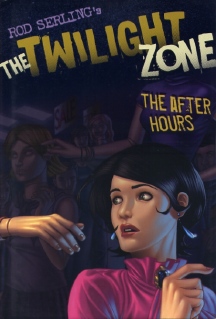
|
A day in the un-life. |
Time is certainly the
arbiter of great stories. One year's indispensable, meaningful literary
event may turn out to be as nothing ten years on; while the cultural fluff
from another era can acquire a heft and power that is undeniable. We've
already forgotten the former, but a fine example of the latter is Rod
Serling's The Twilight Zone. Who would have thought that a television
anthology show from the late 1950's and early 1960's would have the long-term,
sustained, even mythic impact that this program has had? Serling himself
wrote many of the most mythic and iconic episodes; and he was smart enough
to usher in some of the finest writing talent of the time as well. There
have been many attempts to update and follow up the original, but frankly,
none of them have been in the same ballpark.
My first experience with The Twilight Zone was actually not seeing the
show itself, but instead, reading Serling's prose adaptations of his own
stories. And it's the stories that matter here, Serling's ability to corral
the bits of reality and unreality that we mix in our own minds and turn
them into a tale well-told. It's surprising then, that nobody has thought
to do what Walker & Company are doing; turning episodes of the television
shows into finely produced graphic novels.
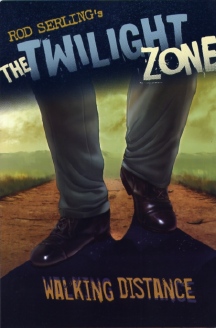
|
|
|
Walk a mile in my shoes. |
I loved 'After Hours'
(Walker & Company ; September 16, 2008 ; $16.99) in hardcover and
'Walking Distance' (Walker & Company ; September 16, 2008 ; $9.99)
in large-format softcovers. The screenplay adaptations by Mark Kneece
were as carefully sparse as the original productions. The illustrations
– Rebekah Isaacs did 'After Hours' and Dove McHargue 'Walking Distance'
– are clean and crisp, again emulating the feel of the original
in a graphic novel format. For my money, the seven bucks extra to get
the hardcover is as nought. These are stories that we already know are
for the ages. You'll want them all in the most durable, nicest format
you can find. But then, as the whole economy circles the drain, well,
getting anything at any price is probably a blessing.
The lessons of these
stories are powerful and ever timely. 'After Hours' promises that coming
next is 'The Monsters Are Due on Maple Street'. Anyone who lived in California
during the power outages brought about by Enron knows the lessons of that
episode. Turn out the lights and change out the government. It worked
once. It will work again. That's the power of myths – and the peril
of ignoring them.
|
Agony Column Podcast
News Report : SF in SF, Featuring Nick Mamatas, David Levine and Terry
Bisson (1) : Nick Mamatas Reads
While I couldnt
attend this month's SF in SF, you can thank Jim Lively
who did – and recorded the show for you. Here's
a link to the first podcast from the show, which is Nick
Mamatas reading his fiction. Finally, justice is served as
I find myself in the rather enjoyable position of getting to hear my own
podcast the way my listeners hear them. You
can find your link – and mine – to the MP3 file right here.
(Perhaps you'll prefer this one to the one above.)
|
| |
|
09-22-08: A 2008 Interview With Beatrice Basso
|
"It's like
the soul of America is in the artists, and why not share that?"
Translation is a tricky
art form – it does not start from within the artist. Instead, the
translator must perform an act of alchemy upon an existing work, using
his or her vision to channel it from one language and just as importantly,
one culture, to another. The intuitive leaps, the restraints of the media,
the demands of the audience and often the players, require a combination
of muscular and sympathetic thinking and skill that is unique and far
more complex than the consumers of translated work might think. I've become
quite interested in the process of translation, because the tension between
the discipline of preserving the intent of the original and the creative
leaps required to translate it are not found in any other art form.
Beatrice Basso came to my attention for her work with
Shakespeare Santa Cruz,
as the first person ever to translate Carlo Goldoni's 'The Antiquarian's
Family' into English. The challenges she faced in this task were many.
She was working not simply as a translator of language, but also as a
dramaturge, a term and occupation with which I was unfamiliar. The breadth
of her work is impressive, but its her understanding of what she
does and her ability to convey the complexities of the translation process
– as well as a lovely voice – that make her interview outstanding.
If you've ever read a translated work that just seemed a joy, to live
and breathe on it's own, then this interview will give you some idea as
to how and why this comes to pass. Bea talks about the hidden layers of
translation; for example, she translates from Italian to English. But
Italian is a language of many regions and dialects which are startlingly
different. Add to this the cultural differences between the two countries
and you'll find that she's called up to give of her own creativity in
a unique and fascinating manner. You
can hear our conversation through this link. I think that many listeners
will find their own understanding of the process of translation is itself
translated after hearing this. You wont read any language without
having that shadow, that perspective – the understanding that any
journey from pen to page is one of invention and intention.
|
| |
|
|







